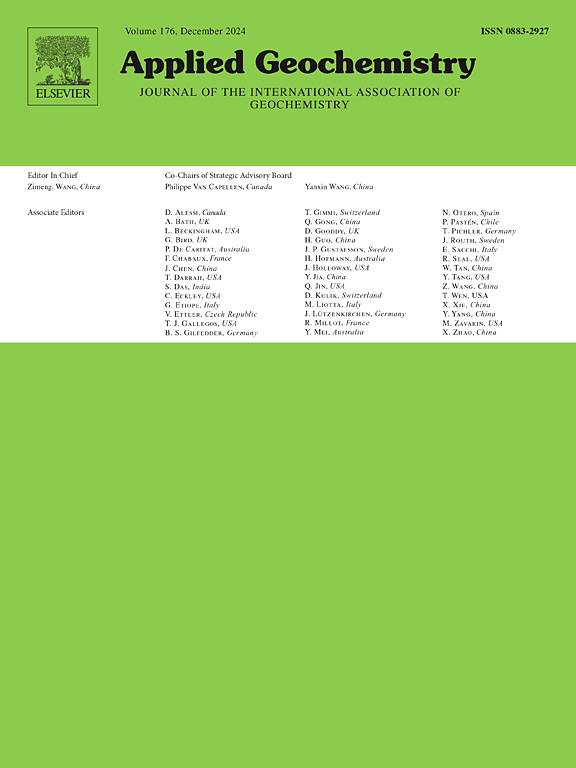Mineralogical and geochemical characterization of mine tailings in the King river delta, Western Tasmania: Implications for long-term stability of trace elements
IF 3.1
3区 地球科学
Q1 GEOCHEMISTRY & GEOPHYSICS
引用次数: 0
Abstract
Nearly a century of mining activities at the Mount Lyell Cu-Zu-Au mine has resulted in the accumulation of ∼14 Mt of fine-grained tailings at the mouth of the King River, Western Tasmania. The tailings consist primarily of sulfides (i.e., pyrite, chalcopyrite, molybdenite, galena), silicates, and amorphous phases such as Fe-oxyhydroxides and sulphates. The long-term weathering of these anthropogenic-deltaic sediments has influenced the geochemical distribution and mineralogical hosts of trace metal(loid)s that are of both environmental concern and economic interest (i.e., Cu, Co, Au, Ag, Mo, As). In this study, the mineralogy, element deportment, and metal(loid) enrichment of variably altered delta sediments were investigated to understand how natural weathering processes influenced the environmental mobility and amenability to reprocessing these waste products.
Micro-scale compositional and textural domains were assessed using laser ablation inductively coupled plasma mass spectrometry (LA-ICP-MS), where metal(loid) relationships revealed a complex multi-stage diagenesis within the sediment. Generation of grain-scale geochemical domains through machine learning cluster analysis support the interpretation of in-situ mineralogical growth zones that influence the distribution of trace metal(loid)s. Eight clusters were identified by their unique mineralogical and chemical composition, revealing that metal(loids), initially bound to primary sulfides, have been remobilized and sequestered by authigenic material. This study demonstrates that the complex hydrodynamic and geochemical processes within the delta continue to influence the mobility and long-term stability of legacy contaminants within this deposit. Results demonstrate that machine learning cluster analysis provides a robust tool to understand the distribution of trace metal(loid)s within unconsolidated mining-impacted sediment that have been altered by complex hydrodynamic and geochemical processes. Knowledge generated in this study is relevant for assessing the feasibility of various remediation strategies, including reprocessing of tailings as an alternative management option.
西塔斯马尼亚国王河三角洲矿山尾矿的矿物学和地球化学特征:微量元素长期稳定性的影响
莱尔铜祖金矿近一个世纪的采矿活动导致在西塔斯马尼亚州国王河口积聚了约14吨细粒尾矿。尾矿主要由硫化物(即黄铁矿、黄铜矿、辉钼矿、方铅矿)、硅酸盐和无定形相(如铁氧氢氧化物和硫酸盐)组成。这些人为三角洲沉积物的长期风化作用影响了具有环境和经济价值的微量金属(如Cu、Co、Au、Ag、Mo、As)的地球化学分布和矿物学寄主。在这项研究中,研究了变蚀三角洲沉积物的矿物学、元素形态和金属(样蛋白)富集,以了解自然风化过程如何影响环境流动性和对这些废物再加工的适应性。利用激光烧蚀电感耦合等离子体质谱(LA-ICP-MS)对微尺度的成分和结构域进行了评估,其中金属(样体)关系揭示了沉积物中复杂的多阶段成岩作用。通过机器学习聚类分析生成的粒度地球化学域支持对影响痕量金属(样金属)分布的原位矿物学生长带的解释。通过其独特的矿物学和化学成分鉴定了8个簇,揭示了最初与原生硫化物结合的金属(固体)已被自生物质重新活化和隔离。该研究表明,三角洲内复杂的水动力和地球化学过程继续影响沉积物中遗留污染物的流动性和长期稳定性。结果表明,机器学习聚类分析为了解受复杂水动力和地球化学过程改变的松散采矿影响沉积物中痕量金属(样金属)的分布提供了一个强大的工具。这项研究中产生的知识与评估各种补救策略的可行性有关,包括将尾矿后处理作为一种替代管理选择。
本文章由计算机程序翻译,如有差异,请以英文原文为准。
求助全文
约1分钟内获得全文
求助全文
来源期刊

Applied Geochemistry
地学-地球化学与地球物理
CiteScore
6.10
自引率
8.80%
发文量
272
审稿时长
65 days
期刊介绍:
Applied Geochemistry is an international journal devoted to publication of original research papers, rapid research communications and selected review papers in geochemistry and urban geochemistry which have some practical application to an aspect of human endeavour, such as the preservation of the environment, health, waste disposal and the search for resources. Papers on applications of inorganic, organic and isotope geochemistry and geochemical processes are therefore welcome provided they meet the main criterion. Spatial and temporal monitoring case studies are only of interest to our international readership if they present new ideas of broad application.
Topics covered include: (1) Environmental geochemistry (including natural and anthropogenic aspects, and protection and remediation strategies); (2) Hydrogeochemistry (surface and groundwater); (3) Medical (urban) geochemistry; (4) The search for energy resources (in particular unconventional oil and gas or emerging metal resources); (5) Energy exploitation (in particular geothermal energy and CCS); (6) Upgrading of energy and mineral resources where there is a direct geochemical application; and (7) Waste disposal, including nuclear waste disposal.
 求助内容:
求助内容: 应助结果提醒方式:
应助结果提醒方式:


